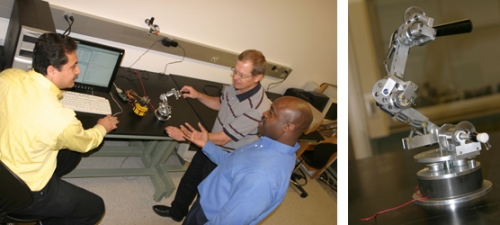
At left: (L-R) Dr. Farzad Ahmadkhanlou, Professor Stephen Bechtel, and Dean Greg Washington examine a manipulator device as interaction occurs with a small scale robot. At Right: A manipulator prototype, similar to the manipulator a surgeon would use in an operation room, has been used in current research at the Intelligent Structures and Systems Laboratory.
There are many definitions for intelligent or what are commonly termed smart structures. In the structural mechanics world a smart structure involves actuators, sensors, and microprocessors. The microprocessors analyze the responses from the sensors and use centralized or decentralized control to command the actuators to respond accordingly. A smart structure has the capability to respond to a changing external environment (such as loads and shape change) as well as to a changing internal environment (such as damage or failure).
Normally a smart structure contains one or more active or smart materials. It is the use of these materials that cause the whole structure to be classified as "smart". These materials have the ability to change their shape, rheological properties (like stiffness and damping), or to change their internal electrical properties like dielectric constant or resistivity. There are many types of smart materials being developed, and implemented in both industry and academe. The typical materials include piezoelectric materials, shape memory alloys, electrostrictive materials, magnetostrictive materials, electro-rheological fluids and fiber optics. These can be integrated with main load-carrying structures by surface bonding or embedding the components in these structures.
